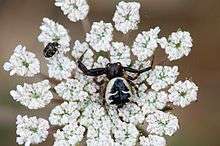Synema globosum
| Synema globosum | |
|---|---|
| | |
| Scientific classification | |
| Kingdom: | Animalia |
| Phylum: | Arthropoda |
| Class: | Arachnida |
| Order: | Araneae |
| Family: | Thomisidae |
| Genus: | Synema |
| Species: | S. globosum |
| Binomial name | |
| Synema globosum (Fabricius, 1775) | |
| Synonyms | |
| |
Synema globosum is a species of spider belonging to the family Thomisidae (crab spiders). It is sometimes called the Napoleon spider, because of a supposed resemblance of the markings on the abdomen to a silhouette of Napoleon.
Description
The adult males reach 2–4 mm (0.08–0.16 in) in length, while females are 7–8 millimetres (0.28–0.31 in) long.[2] They can mostly be encountered from May through August on flowering plants (especially yellow or red Apiaceae species), waiting for their prey.
The two pairs of the front legs, used for hunting the flower-feeding insects, are more developed[2] than the rear ones, which have a predominant motor function.
A striking feature of this species is the variation in colour among females. Mature males have a black abdomen with two white marks. In mature females, the background colour of the abdomen can be red, yellow or white,[3] with a black pattern which has been noted for a certain resemblance to the silhouette of Napoleon.[2] Prosoma and legs are black or dark brown.
Like other species of the family Thomisidae, these spiders do not make a web, but actively hunt their prey.
| Colour variations in females | ||||||
|---|---|---|---|---|---|---|
|
Distribution
This species is present in most countries of Europe and in the eastern Palearctic ecozone, although absent from Scandinavia and the British Isles. It is especially common throughout the Mediterranean region.[4]
Subspecies
- Synema globosum clarum (Franganillo, 1913) [1]
- Synema globosum flavum (Franganilo, 1913)
- Synema globosum pulchellum (Franganillo, 1926)
References
- 1 2 Biolib
- 1 2 3 Guide des mille-pattes, arachnides et insectes de la région mediterranéenne, Joachim et Hiroko Haupt, Delachaux et Niestlé, 1993.
- ↑ Ajuria Ibarra, Helena & Reader, Tom (2014), "Female-limited colour polymorphism in the crab spider Synema globosum (Araneae: Thomisidae)", Biological Journal of the Linnean Society, 113 (2): 1095–8312, doi:10.1111/bij.12338
- ↑ Fauna Europaea
- M.J. Roberts: Collins Field Guide: Spiders of Britain & Northern Europe. Ramsbury, Bath 1995
- A.S. Utochkin: Spiders of the genus Synaema, the group globosum (F.) in the USSR. Zoologicheskii Zhurnal 39: 1018-1024; Moskau 1960

